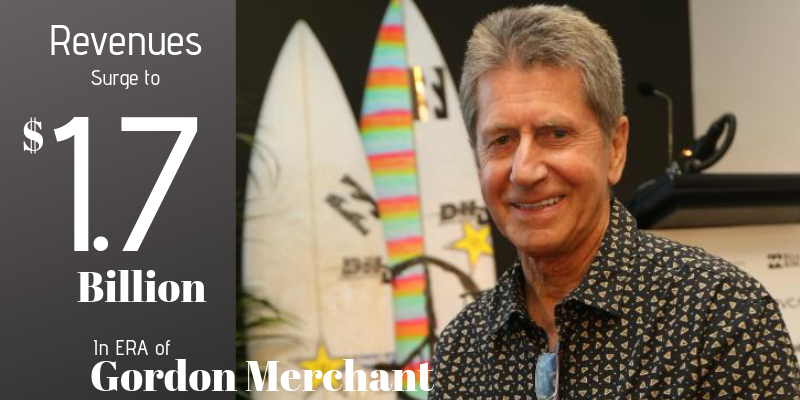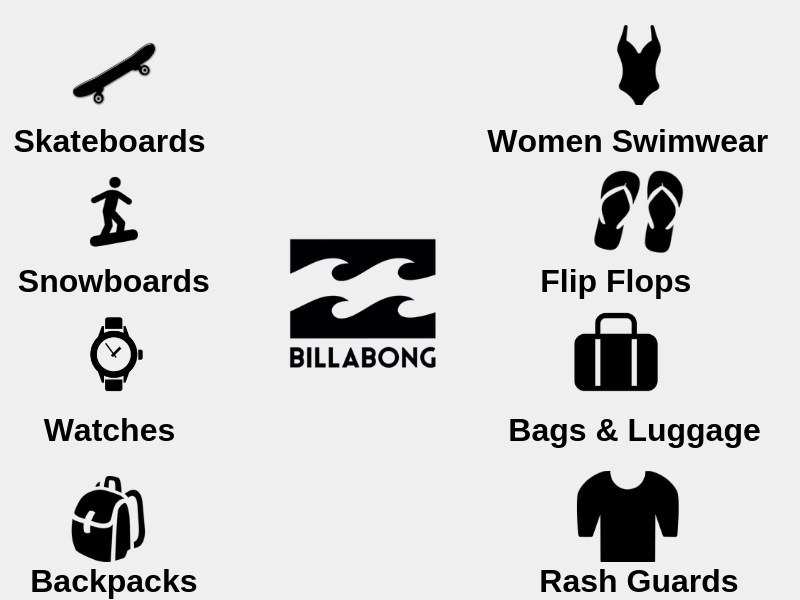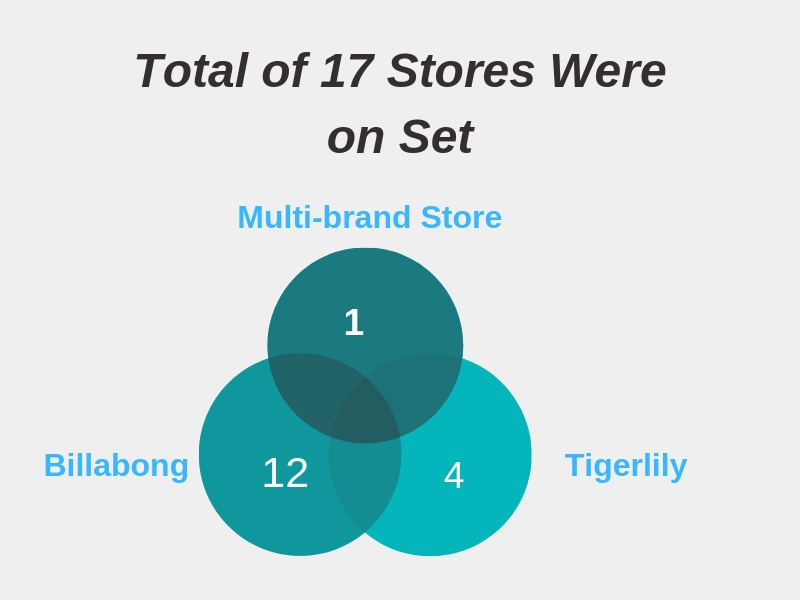Billabong is an Australian clothing company especially serving surfing accessories and apparel is headed by Gordon Merchant. The determination of Gordon elevated the firm to peaks of success as already he was passionate about designing and manufacturing flexible attire for surfing and board sports. He expanded his brand by branching into several other sub-brands which are flaunting the sports industry.
It has numerous notable and modish circumference of stores among the famous ones are Von Zipper which was purchased in 2001, Element, Palmers Surf, Kustom Footwear, Honolua Surf Company, Xcel, Tigerlily, Sector 9 and RVCA. To increase marketing and brand name, Gordon shared the partnerships with Xcel in 2006 and female swimwear company Tigerlily in 2007. The success touched another watermark when Billabong began the process of licensing Plan B, the famous California-based skateboard company, in 2010.

As Billabong expanded multidirectional, Gordon struggled to maintain a prominent image in the world of brands and fashion. Quoting some of the outstanding revenue of the firm, in 2011, it was applauded with the sales uplift of Australian $1.7 billion. However, due to some mismanagement, the profit scale suddenly dropped to 72 percent in 2011.
This was a nightmare for the company and they endeavored tirelessly to beat the market. The team made combat in 2015 as the net profit reached 25.7 million Australian dollars in a short time span. In 2009, it was awarded as the Q150 Icons of Queensland for its exemplary services in the field of innovations and inventions. The restructuring of the company led to the jaw-dropping achievement of Australia $16.097 million.
With such dynamic revenue statistics, let’s celebrate some of the triumphs of Billabong. It is entitled as the number one sponger in the Aussie Water events. It was represented as a leading surf clothing brand by showcasing itself internationally in festivals at Tahiti, Teahupo’o, and Jeffreys Bay in South Africa. It sponsors many sports teams like bike riders who in return act as brand ambassadors and lifestyle supporters.
Billabong is primarily a surfing clothing retailer which sells board sports apparel and accessories, for both men and women. It is acknowledged worldwide for high-performance surfing accessories and durable sports garments, with brilliant discount offers for its customers. It aims to develop the inner coastal lifestyle of surfers and sports freaks. Main items are penned down:

The Success Story of Billabong Departmental Stores
The beginning of the company was welcomed humbly as many brands like Von Zipper and skateboarding sports attire brand, Element was early acquired on shares basis. Tigerlily recognized Billabong as the exclusive brand in the ladies fashion market and the self-slogan of 'Billabongs Girls' was raised. In 2009, it took the charge of Swell, an e-commerce store of board sports brands. It joined hands with Quiet Flight, a retail outlet, which assisted in the addition of 14 Quiet Flight and Surf Warehouse retail stores. The executive department played tactfully and concreted the brand by increasing the associations of other companies. In 2010, hands were shaken with PLAN B, a skateboard company, on the basis of the ten-year licensing deal which was then associated with Element on products corporation. In late 2008, Billabong expanded dimensionally and purchased UK brand of 13 retail stores, Two Seasons.
Due to the continuous flux of losses, the company shifted towards getting revived. To develop the departmental stores, multi brand banners were consolidated, investments were added in the mono brand stores to refurbish them. Global alterations were taken place in the stores for the long term and durable merits to the revenue of the company. A total of 17 stores were on set, among which 12 were of Billabong, 4 of Tigerlily and one multi-brand store.
There was a considerable increment as the sales were boosted by 5 percent portraying that the right investment in the retail store at the right time yielded the best outcomes for the welfare of the company.
How Billabong Came Into Existence?
The
story of Billabong was incepted in 1973 by Gordon Merchant and his wife Rena. They both started manufacturing some handmade knee-length board shorts in their kitchen for the rigors of surfing in Australia. In the early days, stocks of board shorts were sold on the coasts of Australia on consignments of $4.50 per piece. Soon, the business demand escalated promptly because the board shorts were made from high-quality stitching and material of smooth durability, giving sales of $5,000 in the first year.
Later, he named labels of Billabong on the board shorts in 1974 because of increased demand by retailers. By the end of the ‘80s, Billabong initiated its exports of board shorts to California, Japan, South Africa, New Zealand, and Europe, making him successful in accomplishing his sponsoring contests by grabbing global attention. The millennial decade bought much recognition to the
Australian surf industry, evolving it from levels of damage to peaks of global celebrations because of Billabong’s vital participation in the process. Continuing the victory, the first security exchange trade of the company took place on 11 August 2000.
A Fantastic Comeback After A Major Setback
On the route of progress, Billabong suffered a crucial financial and executive crisis because of which 150 stores went obsolete, causing damage to 400 employments. In total, it has suffered losses of $77.1 million. A trend of unprofitable surfwear firms was observed. The value of its brands like Von Zipper, RVCA, Xcel, and Kustom was declined to $106.5 million. Due to the expensive promotions and clearance markdowns, the retail sales went down to 5 percent.
To combat such disasters in the company, the Chief Executive, Launa Inman, presented the proposal of restructuring the firm by focusing on profits and sales. She emphasized key factors of sophisticating the business and upgrading the services of supply chain and e-commerce controls. In contrast, these alterations in the company expensed over $80 million. Substantial strategies were adopted to dig out the company from the recession. For example, Nixon was set a joint venture with 5% of its watches and products were authorized by Trilantic Capital Partners.
On 23rd August 2013, Billabong accepted the offer of US authorities Centerbridge and Oaktree for a US $300 million loan from an Altamont-led consortium. This assisted the firm in regaining its stability by shooting to 58.75 percent of the recovery. The hard work yielded the best results as it was announced that with the help of Guggenheim Securities, the percent stake skyrocketed to 51 and 100 percent for Surf stick and swell respectively.
Impressed with growth? These Strategies Made It Possible
Prior to discussion of the current business strategies of the company, it has started stressing on negating the idea of investing dollars for marketing setups like digital media and is diligently focusing on the concrete customer and brand relationship management. Mr. Fiske, a new international chief executive, is given a charge of reviving the company towards success. She has been working for recruiting new supply chain managers, global IT and HR executives, and supervisors for large-scale brands.
She figured out a turnaround strategy that only raises the slogans of brand and product marketing, omnichannel supply chain controls, and discipline in organization and finance. The company has collaborated with the well-known Lawson Software platform and Lawson QuickStep Fashion for amplifying its sales, manufacturing, and marketing quota in Australia, North America, Europe, Japan, and New Zealand.
Published on: December 30, 2021




